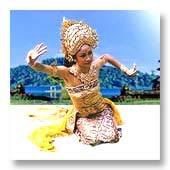Poleng, or chessboard pattern of alternating black and white squares is surely the most distinguished motif of Balinese cloth. One can hardly miss the presence of a poleng cloth around him due to the striking contrast of colors used in the motif. But poleng is not made for attracting attention of the onlookers, it express Balinese point of view towards life.
Since Poleng is the national color of Bali, it can be found virtually everywhere in the island. Poleng clothes are usually wound round big tree trunks, big rocks, statues and shrines. Banners, flags, and umbrellas that are used in a procession of the ceremony sometimes made of poleng clothes. Poleng clothes are also used by the Balinese traditional security forces (pecalang), poleng cloth is considered to be an obligatory part of pecalang outfits. There is also a warrior dance (baris) which is called Baris Poleng. As its name suggests, the dancers’ apparels consist predominantly of poleng clothes.
Poleng cloth is always associated in a way or another to the realm of netherworld. Shrine that is decorated with poleng cloth is usually the shrine dedicated to the spirit of the place where the shrine located, not for gods. Rangda, the personification of negative force of the universe, queen of evil, wears a poleng shawl and when Rangda mask is kept in the box, it is wrapped with poleng cloth. The giant paper doll, ogoh-ogoh, which depicts the evil spirit, is usually dressed with poleng cloth. Stone temple guardians which stand to the left and right of the entrance door of the temples are also wrapped with poleng clothes.
But, what is the significance of poleng cloth? The chessboard pattern of alternating black and white squares of poleng signifies Balinese concept of rwa bhineda, a Balinese view of mutual dualism that make up the whole world. In other word, it is about two opposite thing that depend on each other to exist, such as day and night, low and high, dry and rainy season, bitter and sweet, black and white, etc. Balinese believe that the balance of this mutual dualism will brings prosperity and peacefulness to the mankind. This concept of balance is expressed perfectly by the poleng cloth – the number of white square is always equal with the black one.












